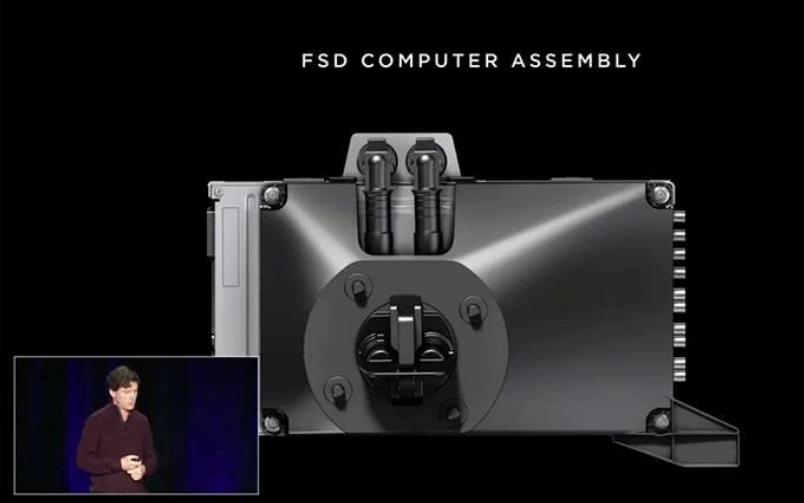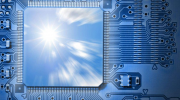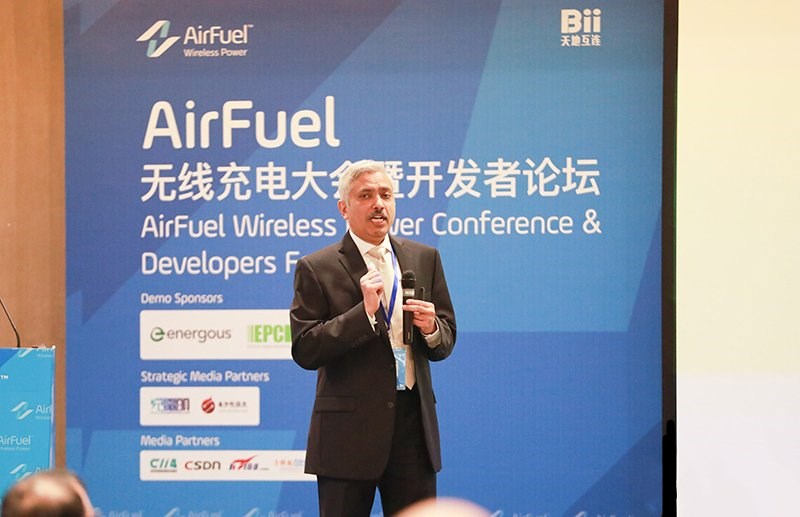Tesla held a Tesla Autonomy Day event at its us headquarters last night, during which it unveiled its long-awaited fully autonomous 3.0 hardware (focused on on-board computers) and its latest development to investors and a global audience.
event
In terms of hardware, based on the dedicated chips for autonomous driving developed by tesla, as well as a series of chips such as ARM A72 CPU, GPU, ISP, etc., its fully autonomous computer can reach the computing power of 144TOPS, but its power consumption is only 72W, and it has been installed in the newly produced models of tesla.

Tesla's fully autonomous computer
From a performance point of view, this is fine. It is the most powerful self-driving computer that has been mass produced.
In terms of software, based on the massive data provided by more than 425,000 vehicles on the road, Tesla continuously improves its AI systems, such as Tesla Vision, to improve the perception, planning and decision-making ability of vehicles, so as to gradually realize the full self-driving ability.
At the event, tesla didn't go into much detail about fully autonomous driving, only saying at the end that it would complete feature development in 2019 and deploy its first fleet of driverless taxis in 2020.
Peter Bannon introduced tesla's self-developed fully self-driving on-board computer, hereinafter referred to as FSD (Full self-driving) computer, which is the core of its 3.0 version of self-driving hardware.
According to the introduction, the internal core of the computer is two dedicated chips for automatic driving developed by tesla based on the 14nm process, as well as a variety of chips such as GPU, ARM A72 CPU and ISP.
Thanks to a strong array of chips, the FSD computer can finally achieve 144TOPS with a power consumption of 72W.
At the event, tesla also sent out a powerpoint slide comparing it to nvidia's self-driving computer Xavier, which has a 21TOPS computing power.
Of course, the latest nvidia figures are 30TOPS and 30W.
Using this parameter, the performance-to-energy ratio of tesla FSD computer and Xavier is 2TOPS/W and 1TOPS/W, respectively.
Obviously, tesla's FSD computer should have become the strongest on-board computer in the field of autonomous driving.

Tesla fully self-driving computer shape
More importantly, musk stressed on the spot that all the tesla models currently in production are already running 3.0 hardware.
The Model S/X was launched with the latest computers a month ago, and the Model 3 10 days ago.In the coming months, older models will also be able to switch to 3.0 hardware.
Finally, musk revealed that the next generation of his chip is already in development and will be more than three times more powerful than 3.0.
The first driverless taxi fleet will be deployed next year
At the sensor level, the 3.0 hardware is still configured with 8 cameras +1 millimeter wave radar +12 ultrasonic radars.
When asked why they don't use lidar, musk and tesla's self-driving executives still joke that it's expensive, limited in performance, and for fools.The human driving is only on the vision of this sensor can, and the visual sensor has the most complete sensory information.
Tesla's fully autonomous sensor placement
At the software level, tesla is still relying on AI technologies such as Telsa Vision to improve the perception, planning and decision-making abilities of its vehicles.
According to the company, 425,000 tesla vehicles with 2.0 version hardware are currently on the road.Autopilot has driven more than 70 million miles, including 9 million miles of successful lane changes.
Thanks to such a huge amount of actual driving data, tesla is also using its shadow mode to continuously enhance its Autopilot system and develop a fully autonomous driving system.
Tesla's perception of autonomous driving
That is, tesla will run its autopilot system in the background when the user drives, and compare the decisions made by the system with those made by human drivers, so as to continuously improve its own system.
Unfortunately, tesla has not introduced the functional details of fully autonomous driving, but the focus is actually on the FSD on-board computer.
At the end of the event, musk said tesla would achieve full self-driving capability development in 2019, while going on to deploy the first fleet of commercial driverless taxis in 2020.
Tesla will deploy an unmanned taxi fleet in 2020
By Mr Musk's calculations, the economics of driverless taxis are superior.
According to the data it Shared, tesla's driverless taxis cost less than $38,000 per bike, can run 4.5 miles per kilowatt hour and cost less than $0.18 per mile to drive.
As a driverless car, it can work 16 hours a day and has a total mileage of 90,000 miles a year.
At $0.65 per mile, each car brings in $30,000 a year and can last 11 years.
One notable detail is its business model.
According to musk, tesla will build a sharing platform for driverless taxis, where car owners can share their vehicles to provide ride-hailing services, and tesla will take 25-30% of the fee.
Tesla will provide its own vehicles if not enough local owners share them.
Four and a half years on the road to tesla's self-driving evolution
Autonomous driving has been tesla's signature technology since the company launched its mass-production cars.
Its L2 AutoPilot, the first version of tesla's autonomous driving system and available only for the Model S P85D, was first introduced on October 9, 2014.
This version of the autopilot system, developed by tesla in partnership with Israeli self-driving company Mobileye, is powered by the company's EyeQ3 chip. The hardware sensor includes a forward-looking radar, a forward-looking camera and 12 ultrasonic radars covering a 5-meter area around the vehicle.
The Model S equipped with AutoPilot system can maintain the lane, automatically change the lane when the steering signal is used, and actively control the speed by identifying the road signs and sensing the surrounding traffic environment.
Tesla Autopilot
On October 14, 2015, tesla announced that the AutoPilot system is available to users with a 7.0 software update. In this update announcement, tesla mentioned that the AutoPilot system already has automatic parking.
Then, in an update on January 10, 2016, tesla released a version 7.1 software that added a phone call feature to the AutoPilot system.It is known that this function is called summoned remote parking. Users can use their phones to open the garage door remotely and give instructions to tesla cars so that they can park themselves in the garage.
When the car is needed, this function can open the garage door remotely, and tesla's car can respond to the call of the owner and drive to the location near the owner (when the car is not far away from the owner).
Tesla's honeymoon with Mobileye ended in July 2016, followed by the launch of AutoPilot 2.0 hardware in October 2016 in partnership with Nvidia, and the official launch of AutoPilot 2.0 in February 2017.
This version of the autopilot based on Nvidia hardware Drive PX 2 AI computing platform to build, with a forward-looking radar detection range of 160 meters, three front camera, at the same time, in the body of the left front, left, left rear, right rear respectively carrying a camera, at the same time also has a detection range 50 m rear view cameras, car body around 12 ultrasonic radar detection range from 5 meters to 8 m.
This version of the autonomous driving system can achieve adaptive cruise, highway autonomous driving and local public road autonomous driving.Previously, on August 31, 2016 tesla 8.0 system, tesla's AutoPilot system main sensor by the camera into the radar, by processing the radar signals to create similar to the laser radar imaging formation of thick point cloud, this update makes the tesla AutoPilot system can be in low visibility conditions for navigation.
In July 2017, in order to further improve the reliability of AutoPilot system, tesla released the AutoPilot 2.5 version of hardware, which increased the detection distance of the front-facing camera to 170 meters, as well as the redundancy of calculation and wiring. This update was applied to the tesla car produced in August 2017.
Then, after a year and three months of research and development, on October 28, 2018, tesla took the lead in delivering the Navigate on Autopilot function to users in North America. It added the semi-automatic on-off ramp function to the original functions of single-lane automatic driving and semi-automatic lane change, and now it has preliminarily prepared the prototype of the Autopilot system above L3 level.
Tesla Navigate on Autopilot
It should be noted that after this function is enabled, the driver still needs to pay attention to the surrounding road conditions at all times and confirm the lane change command. If the driver has been away from the steering wheel for too long, the system will still issue an alarm to remind the driver to focus on driving.In this version of the automatic driving system, the driver is still the main responsibility, so this system still belongs to the automatic driving system below L3.

 Englisch
Englisch  Chinesisch
Chinesisch  Deutsch
Deutsch  Koreanisch
Koreanisch  Japanisch
Japanisch  Farsi
Farsi  Portuguese
Portuguese  Russian
Russian  Spanisch
Spanisch 





